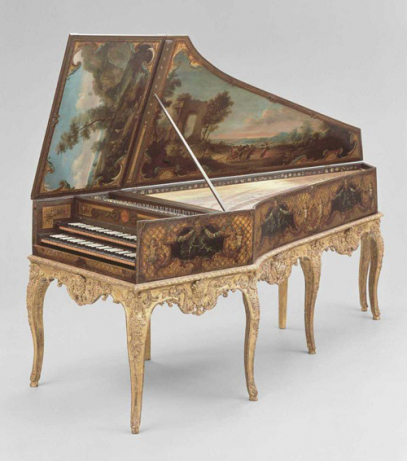French harpsichords
Harpsichord, Henri Hemsch c1736, Museum of Fine Arts, Boston
This late two-manual instrument is rather typical for French harpsichords of the 17th and 18th centuries. For these instruments the French clavecin compositions from Couperin to Rameau were written, and they also served as models for harpsichord makers elsewhere (except Italy).
Musikbeispiel:
Giovanni Benedetto Platti (ca 1690-1763), Sonata D, 1st movement Adagio
from "VI Sonates pour le Clavessin sur le gout italien" 1742
played by Christoph Hammer
Instrument: Harpsichord by Henri Hemsch, Paris 1770
French harpsichord makers of the 1700s were maybe the greatest admirers of the instruments by Ruckers and other Flemish makers - but the history of French harpsichord making is one of almost planful destruction of Flemish harpsichords. The beginnings of French harpsichord making are obstructed by the fact that hardly any before 1650 still exist. The earliest extant instruments are somewhat lighter and shorter than Flemish harpsichords and take an intermediate between Italian and Flemish instruments., with a peculiarity in being with two manuals and three ranks (2x8’+4’) throughout.besaßen. In contrast to Flemish two manual-instruments allowing transposition but sounding the same. the two manuals of French instruments sounded differently offering the opportunity for expressive contrasting play.
Around 1680 the Flemish "dynasty" Ruckers-Couchet died out and the steady influx of new instruments from Antverp fell dry. At about the same time the wish appeared to increase the compass of instruments (from traditional C-c3 to F’-f3). The "solution" for these problems popular among Parisian makers was called Ravalement, a procedure, which some workshops like those of the Blanchet family (later Taskin) developed a masterly level in, but sound horrifying for many a lover of old harpsichord even today: Taking a Flemish harpsichord apart for the beginning, then sawing it length-wise, then adding extra slabs of wood to the frame and the soundboard to lengthen and widen it. Wrestplank keyboard, jacks and stop mechanisms were made completely new (and - believing contempary reports - far more precise than before). Further specifically French "improvements" were a manual coupler, the new Peau de buffle stop with quills of buffalo leather, and the knee levers invented by Pascal Taskin to change stops.
By doing so it was hoped to preserve the sound qualities of the Flemish instruments while adapting to the new requirements of French clavecin music. No doubt this was successful in its own radical way but left hardly a Flemish harpsichord unaltered.
These instruments after the Grand Ravalement (and the new harpsichords modelled after them built in France) were impressive for their sonority and their playing characteristics even outside France eg in England and Germany. But in France many instruments were destroyed in the aftermath of the French revolution as symbols of the Ancien regime.
© Greifenberger Institut für Musikinstrumentenkunde | info@gimk.org




